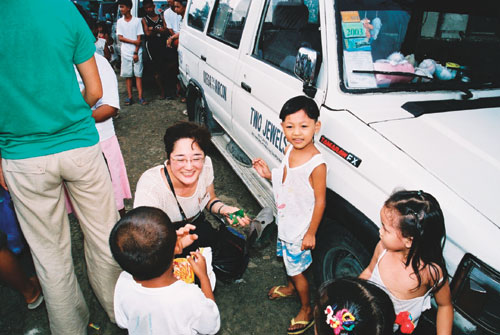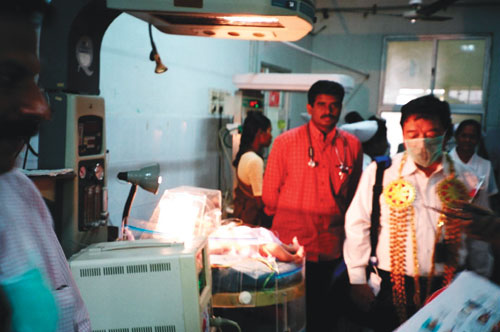Japan's Official Development Assistance White Paper 2005
Column II-11 Observing ODA On-site
The Monitoring Group of Citizens on Japan's ODA is a system to deepen the understanding of ODA by sending Japanese citizens who support ODA, to observe the project directly on-site. In FY2004, a total of 59 people observed ODA projects in six countries separately (Timor-Leste, China, Cambodia, India, the Philippines, and Indonesia). Among them, Ms. Nahoko Sato (lecturer; Philippines observer) and Mr. Shigeharu Matsumoto (company employee; India observer), stated their impressions, as below, after the monitoring.

Ms. Sato interacting with Filipino children, smiling (Photo: Association for Promotion of International Cooperation (APIC))
Ms. Nahoko Sato
During my observation in the Philippines, I was welcomed everywhere by people, saying, "We thank the people of Japan." I myself did not feel that I personally had done anything to support the Philippines, but I was happy about such appreciation from local people.
In the Philippines, there is a large gap between the wealthy and the poor. While the cities bristle with high-rise buildings, the streets are endlessly lined with barrack-type housing. The population is polarized into those who enjoy prosperity and those who must struggle on a daily basis.
In order to improve the conditions of the poor, we need to help the people in those areas develop their ability to make a living for themselves. In this regard, the persons who serve as leaders are the Japanese experts and the members of the Japan Overseas Cooperation Volunteers. They are quite the face of Japan.
It is such assistance with a visible face that will support the future development of the Philippines as a good partner of Japan. After monitoring, I was able to perceive the significance of ODA once again.

Mr. Matsumoto observing a hospital in India (Photo: Association for Promotion of International Cooperation (APIC)
Mr. Shigeharu Matsumoto
In India, which accounts for approximately 16% of the world population, almost one-third of people live in poverty. I observed ODA projects in this country and felt like this:
First, I felt that each project is implemented in a balanced manner, ranging from such national projects as construction of subways and open universities to rural area reforms and provisions of equipment to hospitals for the poor and facilities for disabled children. I also felt that many people appreciate these projects.
Next, I realized that the widespread perception that Japan's ODA creates "nothing but hardware and leave them neglected afterward" is a mistake. ODA projects are carried out based on requests from parties like developing countries, and are turned over to them once the projects are completed. Before the monitoring, I, too, had mistaken inadequate responses by recipient country's post-project completion as faults in Japan's ODA measures themselves. 1
In terms of challenges for the future of ODA, financial cooperation is surely important; but I think that cooperation and exchanges of people who would sweat alongside the local people are also particularly crucial. Through this experience, I strongly felt the importance of continued efforts by ODA staff, as well as our understanding and support.

